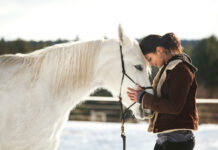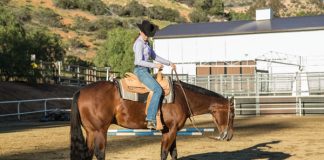
There’s more to polo than chukkers, mallets and fancy horses with closely cropped manes. If you want to investigate the game and see if you really do have a passion for polo, try taking a few lessons with an established instructor. Most polo clubs can refer you to a polo school. Introductory lessons generally cost $50 to $150 per hour, which includes all tack and equipment plus the use of a trusty school pony. The only prerequisite is that you should be a confident rider with a well-balanced seat on a horse, especially at the canter. Once you can ride competently, the next step is getting used to the rules of the game.
Sherry Sheldon is a lifelong California horsewoman. When she’s not playing polo herself, she’s teaching polo lessons to aficionados of all skill levels from her Polodeo Ranch in Poway, Calif. One of her biggest challenges is dealing with polo novices who are perhaps a bit lofty in their aspirations.
“The typical new polo player is the man who wants to come out and get right into the sport, sort of macho-like, even if he’s never been around horses much,” Sheldon says.
Once they climb in the saddle and get a taste for the intricacies of the sport, that bravado usually disappears. Swinging a mallet at a gallop while avoiding traffic is a supreme example of multi-tasking on horseback. Just as dressage newbies ride Training Level tests and green jumper riders course over crossrails, beginning polo players have to polish their fundamental skills.
“Fortunately,” Sheldon says, “thanks to the handicap system, like players are matched up in competition with like players. There’s a level for everyone. For example, in the student (entry) level matches, riders never get beyond walking and trotting.”
That may sound simplistic, but playing at a snail’s pace is important until an aspiring polo player develops the right instincts and technique. Although the competitive urge is to chase after the ball, a syndrome Sheldon refers to as, “See ball, go ball,” that would be ignoring the rules of the game.
“The hardest part to learn is not the various mallet swings, but the line of the ball. That’s the imaginary dotted line, both in front of and behind the ball, that marks its potential path. There are very strict rules about when you may or may not cross that path, and where you can hit the ball from,” she explains. “You have to adjust to the line of the ball. But you can’t stop and ponder your position because other riders are galloping up behind you. In the heat of competition, that’s hard to do. But it’s necessary,” she says with a knowing laugh, “because otherwise you’d have this wild melee, a field of people on horseback all blindly whacking at a ball.”
Like any equestrian sport, polo requires a certain amount of natural ability combined with determination and dedication. By taking a few lessons, you may discover that, yes indeed, you do have a passion for polo!






That would be so much fun! It comes at a pretty hefty price though- I couldn’t afford up to $150 per hour!
I just started playing polo this semester in college (in CT) and i wanted to continue lessons when i go home for the summer. i live in NJ and am having trouble finding a facility that offers polo lessons..
I would love to learn how to play polo! Are there any instructors close to the Maple Grove area?
[…] https://www.horseillustrated.com/english-horse-training-polo-lessons […]